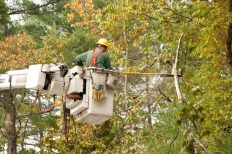
Importance of Trimming for Growing Beautiful, Safe and Healthy Trees
Trees provide a soft, serene beauty to the landscape yet it’s easy to take them for granted. Especially since they ask for so little and give so much. And even though they can do well without much help from us, intense weather, diseases and pests can take their toll. To ensure healthy and resilient trees, it takes more than just watering effectively and protecting their roots. It’s important to properly prune and trim them as well.
However, incorrect trimming can do more harm than good. Here’s a friendly advice: Don’t do it yourself. Having your trees trimmed by yourself could be just as bad as not having them trimmed at all. Improper cutting can seriously hurt the tree what can lead to decay. Only an experienced landscaper or an arborist can make sure the process runs smoothly. Plus, they know when it’s best to trim. Do you?
Of course, it should be done as soon as you see any damaged, diseased or dead branches, however it’s best to do it either after your trees have finished blooming or during colder months when they don’t produce any sap and bacteria and fungi are inactive. This minimizes the risks of infecting trimming cuts.
However, tree trimming goes beyond improving trees’ health. It can improve your view and keep your landscape aesthetically pleasing. Not having your trees trimmed and letting them grow wild could make your home look abandoned. So unless you’re going for a mystical, Maleficent-style scenery, give your trees a haircut.
Partnering with a tree trimming professional will do more than just maintain your property’s curb appeal. Since landscapers are well versed in all components that make up a functional and attractive outdoor space, hiring professionals for tree trimming will help to minimize the risk of harm to your family and damage to your home’s exterior and landscape.
Dried out and loose branches can often be dangerous – they could fall and hurt passers-by what can result in a costly lawsuit. Or even worse, you or your closest ones could become the victims of a fallen branch. Another important thing concerning safety is the direction your trees grow in as sometimes they could interfere with power lines on or near your property. By trying to show off your DIY skills you run the risk of getting electrocuted, therefore don’t tempt your fate, have an expert assess the situation and trim the menaces off. They have the experience and tools to safely cut large limbs without damaging power lines.
However, trimming is not performed only for the purpose of removing branches that are dead or dying. Regularly thinning a dense canopy will reduce the weight on the tree’s trunk, making it less likely to fall from overburdening or a heavy snow fall. Besides keeping trees from developing broad or weak branches, trimming can also increase air circulation and sun exposure preventing excessive soil moisture. Moist environment is a recipe for many fungal diseases, insect infestation and tree decline.
And for those of you who’ve decided to test your green thumbs by planting one or more fruit trees, here’s a tip: Regular removal of diseased, broken or already dead branches increases sun exposure resulting in improved quantity of the crop and richer and juicier fruit production.
Remember, a landscape without a tree just isn’t the same. Trees that are well taken care of invoke a certain forest charm, keep the air clean and animate the garden with soothing bird songs. So, if you want to ensure the living sculptures that tower over your landscape keep creating alluring outside scene, give them some TLC. Remember that a little love goes a long way.
